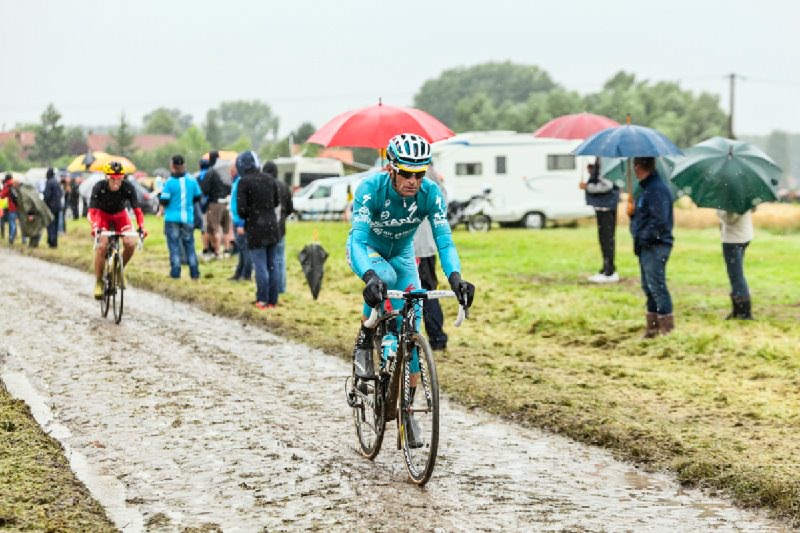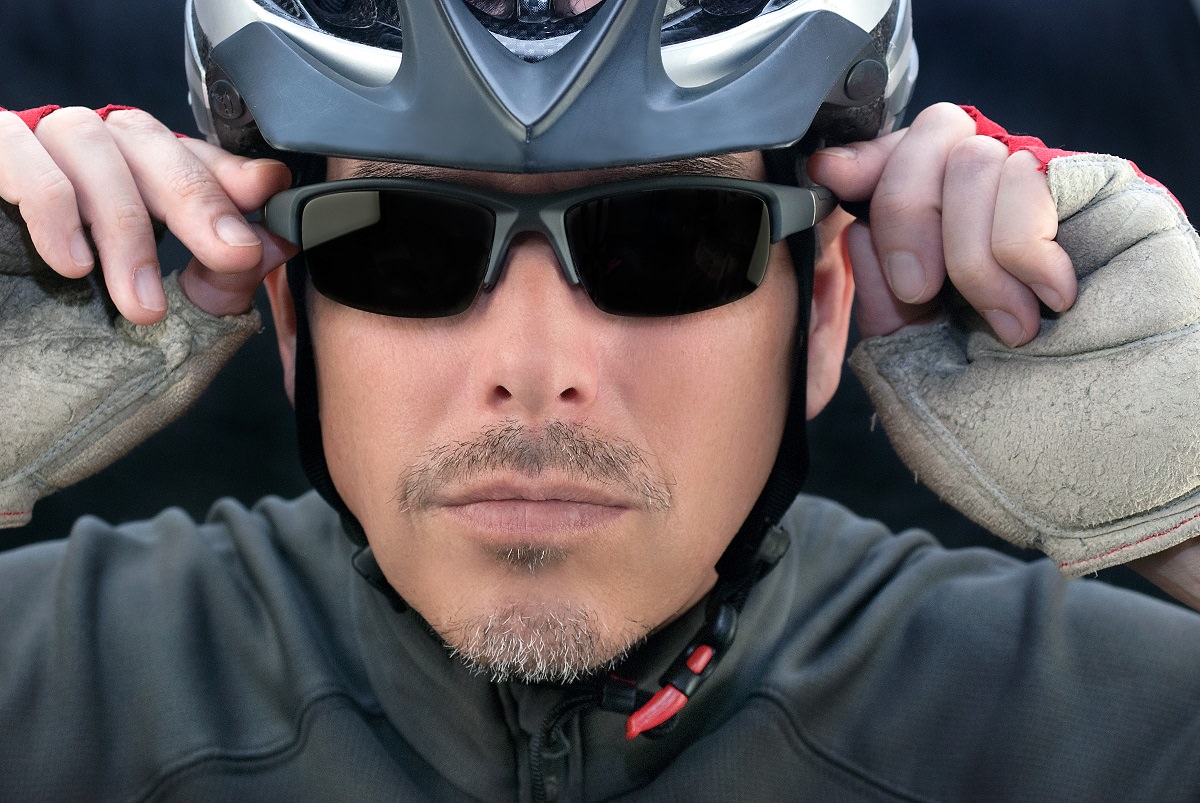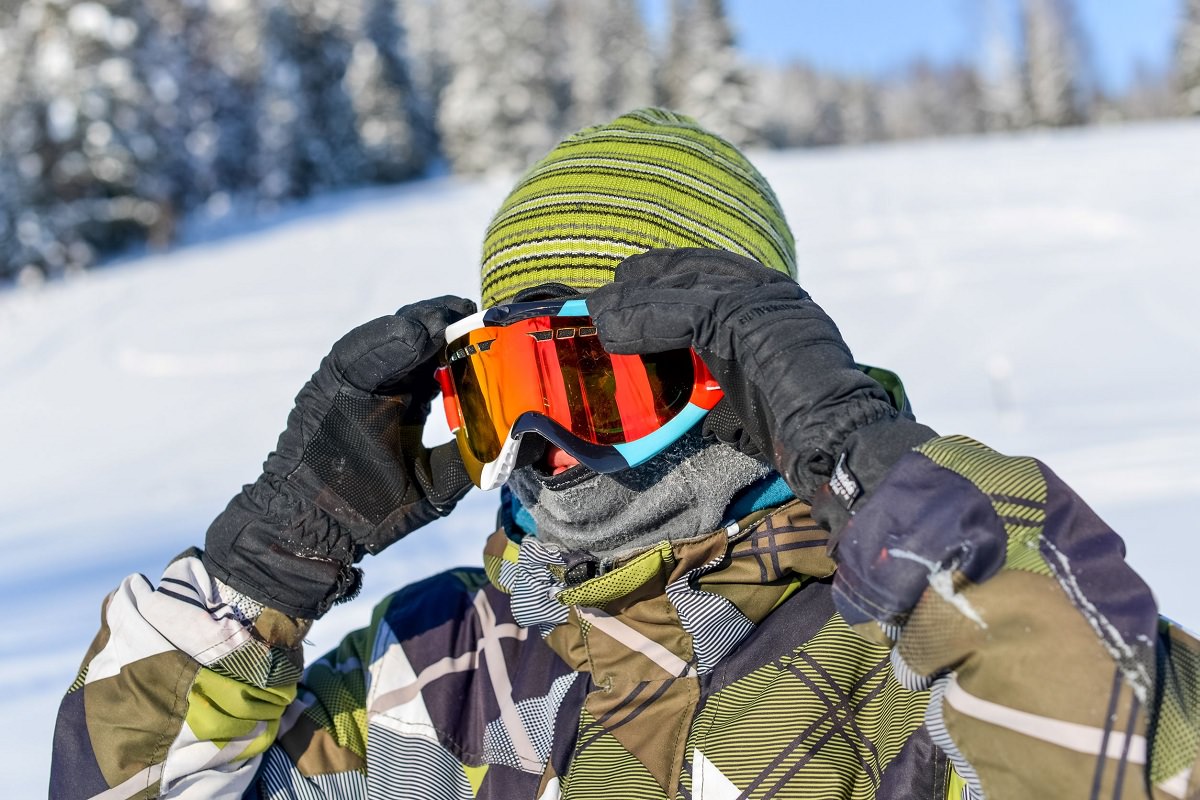Icebikers have more reasons to wear glasses than most cyclists, and more problems with them too. In addition to prescription lenses, other reasons to wear glasses include howling winds and blowing snow. When riding on broad expanses of snow, such as a frozen lake, sunny days can be so bright as to be downright painful, and snow blindness (photokeratitis) could result. Some forms of Sunglasses are called for.
For many icebikers, the need to wear glasses means dealing with all the usual winter hassles that glasses seem to bring. Seldom a problem in summer, glasses in winter are subject to fogging over seemingly at every breath, and in some cases frosting up to the point that you simply must stop and clean them. Even moderately fogged glasses can obscure ruts in the trail leading to some sudden spills.
How To Choose The Best Winter Cycling Goggles
In the wet weather of fall, rain buildup on your glasses can be a constant annoyance and can impair your vision to the point you may hit that patch of broken glass that you’ve successfully avoided every day this week up till now.
1. Prescription glasses
Prescription lens wearers often have no choice. They have to wear glasses just to be safe. The attendant fogging and frosting can be manageable with little tricks every eyeglass wearer learns over time, blowing breath down – or over your shoulder, cocking your head to the side to let air flow behind the lens to help clear away the fog, etc.
In addition, there are other steps you can take to reduce fogging and frosting.
2. Ski goggles
In blowing dry snow, or severe cold, you may want to try ski goggles. These are made with colored or clear lenses and come in sizes that can be worn over eyeglasses. Newer smaller goggles, while not accommodating eyeglasses, can be fitted with prescription lenses, and look less alien.
The best I can figure, even skiers don’t like ski goggles. They are the last item put on before a run and the first taken off. They can be confining, hard to get on and off, and can restrict your vision.
Skiers seldom have to worry about the 18-wheeler coming up from behind in the next lane. Cyclists do. Be sure to try them on and see if you can still see behind you. I have tried them but found them so restrictive of the over-the-shoulder view that they simply were not suitable for transportation cycling. Other icebikers, usually from much colder climates, report good results. You have to be the judge.
3. Safety goggles
Icebiker Marvin Lewiton reports: “I’ve got another tool for eyewear – they’re called “VisorGogs”, and are available through various health and safety product vendors.
Designed as impact or splash protection, they’re a one-piece lens attached to a brow pad and use an elastic strap to hold them on your head. As an eyeglass wearer, I find them great for wind/snow/sleet protection while riding. I use them over sunglasses on really cold days. They also seem to direct rain downwards – not sure of the aerodynamics involved, but it sure beats riding without them. Replaceable lenses for when (not if) they get too scratched.”
Lenses are available in various colors, are light and non-confining, they work over regular glasses, and they don’t make you look like you just came out of a welding shop. VisorGogs are manufactured by Jones and Company and are available for under $7 from Lab Safety Supply, and they have a far more “nerdy” picture on their web page.
Independent review available Here.
2. Sun Glasses
It’s no accident that Inuit (Eskimo) people invented sunglasses thousands of years before anyone else. Bright days on snow can be tough on your eyes. That sunny Saturday on the frozen lake can leave you with a mild case of snow blindness. (technically sunburned cornea).
Even regular sunglasses or cycling glasses may provide enough protection. Tinted Ski Goggles would also be helpful.
Some colored lenses, notably yellow and red, enhance contrast and can make bumps or ruts in the snow stand out more clearly, even on overcast days. The early sunglasses designs (shown at right) also didn’t suffer from fogging, because they had no lenses.
Tips For Rain riding
For rain riding there are a few chemical approaches to keeping your glasses free of rain and the associated fogging. Not always effective, and sometimes just snake oil, various remedies have been tried over the years. Among those the icebikers find worth mentioning are the following:
1. Treat the lenses to shed water
Some icebikers have used RainX for this during the rainy season. Made for automotive windshields, RainX increases surface tension, causing drops to hold together, and not adhere to the glass surface. You don’t need your wipers at automotive speeds as the wind will blow these large round drops off your window. At cycling speeds, an occasional sharp shake of the head is sufficient to dislodge most of the rain.
In heavy fog, RainX can cause the fog to bead up into microscopic beads, but never achieve a size sufficient to fall by their weight, even with a shake. In cold weather, RainX does not seem to help, and fogging still occurs.
Is RainX safe for eyeglasses?
I posed this question directly to the customer support representative of the RainX manufacturer. Their reply:
“Rain-X is a strong Alcohol solution before applied and would be an eye irritant. Once applied, however, the polymer will not harm the eye or be toxic in any way.
Rain-X is safe on all glass lenses that don’t have anti-glare coatings. If your prescription lenses have such coatings DO NOT USE RAIN-X ON THEM or they will not be coated for very long.”
2. Treat the lenses to sheet water
Sheeting water is exactly the opposite approach. With sheeting agents (the cheapest is dish detergent) we attempt to break down surface tension so that the water, while it will still adhere to the lens, will flow smoothly over it and drip off the bottom. There will be some distortion of vision, but not as much as having the lenses full of raindrops.
Just put one drop of detergent on each lens, rinse lightly, and don’t dry them so thoroughly as to remove all the soap. Don’t leave a visible film, it doesn’t take a lot.
3. Other commercial treatments
More than one icebreaker has recommended “Cat Crap” as an anti-fog treatment. This is billed as a lens cleaner, which leaves a residue that prevents fogging. Available from Campmor and other outdoor vendors.
The RainX company has a new anti-fog product which they claim is good for eyeglasses. It is called, imaginatively enough, Anti-Fog, and is stated to be a “micropolymer” treatment for glass and plastics that prevents the formation of Fog. No one I know has tried this product, as it is rather new.
FogTech Review

I tested FogTech by applying it to one lens of a pair of prescription eyeglasses and leaving the other lens untreated. Both were washed with soap and water and dried completely before the test began.

I then went out in the snowy damp Southeast Alaskan winter on our test ride with one lens treated and one lens clean. I had just had a heavy dump of wet snow. But by the time I hit the road, it was slush and constant mist. Huffing and puffing through the churned-up snow, I expected prime fogging conditions. As luck would have it neither lens fogged on this ride. But I did find the “oil sheen” annoying. This can’t be right, I thought.
Back at the hearth, I cleaned the classes again with soapy water. This time I applied FogTech sparingly. Very sparingly. One drop per lens. This still left a fine but visible mist. We just could never get it right. However, I was able to demonstrate that the lenses did not fog, as long as I was willing to put up with mild visual deterioration (fogging) due to the anti-fog treatment.
Tips For Cold Weather Riding
The most difficult temperatures for fogging are within 5 degrees above or below freezing. There is plenty of moisture around, and all of it seems attracted to your lenses.
When stopping, your breath rises around your glasses. Unzipping your jacket you will release a small cloud of warm moist air. You will often find your lenses fogging up at every stop sign, and clearing by themselves as you get going again.
Well below freezing, fogging of glasses is usually caused by your breath condensing on your lenses. Really cold air is also very dry, and moisture tends to disperse instantly. Often fogged lenses will clear by themselves in a minute or so. Simply by riding along, providing some ventilation from movement through the air, you will often be able to de-fog lenses. Those fitting close to your face will be harder to defog by ventilation.
If fogged lenses don’t clear themselves quickly in real cold weather, the condensate will freeze and you will have to stop clearing it manually.
Conclusion
That’s it for now. One more thing before I go! Make sure that your winter cycling goggles are impact-proof. They’d be great in case you fall!
Also Read
- How To Choose Between Winter Cycling Gloves, Pogies And Mittens
- How To Choose Extreme Winter Cycling Shoes, Boots And Footwear
- Winter Cycling Techniques For Any Kind Of Snow And Ice
Should you have any questions or require further clarification on the topic, please feel free to connect with our expert author John Andersen by leaving a comment below. We value your engagement and are here to assist you.




7 thoughts on “How to Choose the Best Winter Cycling Goggles”
Hi admin, i must say you have high quality content here.
Your website should go viral. You need initial traffic
boost only. How to get it? Search for: Mertiso’s tips go viral
Try Kroops – great product!!
Hi,
Great article, but as seems to be the real situation, it is inconclusive.
I am a 4-season cyclist, in a snowy climate, who is not very good at going at a relaxed pace. I wear glasses for vision and I do not want to use anti-fog treatment each time I ride (since it do so at least ten times per week).
Spring through autumn is ok:
No problem in any weather: any fog that collects when I am stopped at a red light, disappears pretty quickly when I start up again. I have basic anti-fog treatment on the glasses which helps bead the water. This means that, in the rain, my eyes can easily focus on the road and not even notice the drops on my lenses.
Winter, however, sucks:
I wear a ski helmet and have ski goggles. Since I started skiing when I was young, I easily adapt to the restricted field of vision. (When you are cycling in the city, your head tends to twitch like a pigeon anyway…and as you spin your head from one place to another, you overcome the limitations of the field of vision.) However, fog on my glasses is the enemy. Once I warm up–which is otherwise a welcomed stated–my glasses start to fog and I need to remove them, no matter how much the snow is blowing. This is not only uncomfortable while I am riding, but can also strain my eyes so they can be fatigued and dry afterwards.
I have asked around and nobody I spoke to knows what to do. I have (today) taken the following steps:
1. I bought a new ski helmet with vents right above the goggles
2. I cut small holes in the upper venting foam to help increase the ventilation in the googles. I am reticent to cut on the bottom since I don’t want my breath getting inside the goggles.
It is unfortunate that no eye-wear manufacturer (that I know of) has seized this opportunity. Ski goggle protect the eyes, but the speeds when cycling through snowy streets are much reduced when compared to skiing down the slopes and the cardio experience is greatly increased (i.e. much more perspiration on the face), translating to fogged glasses.
I checked the protective eye-wear, but it does not look like it will fit comfortable over glasses. Also, it looks prone to fog (and frost).
I guess I am writing this as an SOS in the bottle…if anyone has some good ideas or products…
I also am concerned about fogged up and frozen goggles. My challenge: would fan attachments work better than heated lenses? I’ve seen both on Amazon but no reviews on Ice Bike sites.
Hey guys, thanks for the great website! You have taught me much over the years – this is my 14th winter commuting daily on bicycle in Minneapolis, thanks to you.
I wear ski goggles below about 25F to protect my eyes and the skin around them in the opening of my balaclava. I have had major goggle fogging issues (fogging inside the goggle) in the coldest weather (below 0F). Here is what I’ve experienced/learned (at least from my perspective).
Standard ski goggles need dry air moving inside to stay clear when riding. I fought foggy goggles from ~20F and below for years. I worked on the seal around my nose and other ways to keep breath away until I eventually removed the foam from the top and sides of the goggles, and made sure my helmet has a gap above the goggle to let air in.
This technique allowed me to ride with clear vision down to around 0F, but below zero fog/ice starts to creep back in. I believe this is because of brow sweat and the liquid layer on my eyeballs evaporating inside the goggle and depositing on the cold inner lens. While a dry air flush from outside helps, it helps less and less as the temperature drops. At -15F and below, there is essentially nothing I can do. A tail-wind makes it worse – less force to drive air into the goggle.
One might expect as it gets even colder, the function of the goggle (to protect the eyes and skin) will fail due to the cold air flush.
I am intrigued by the heated goggles available and would like your thoughts on them. It seems like they would solve my problems, but the articles I read are from snowmobiling enthusiasts, not cyclists. Does anyone on this forum have experience with them? Thanks!
Thanks, Kevin. Good information. Sounds like I should try the heated lenses.
Wow, this is really useful information Kevin, thanks! I have only been winter bike commuting a couple years, but here in Madison WI have had almost the same experience with regards to temperature ranges, trying to fiddle with balaclava, etc (I still have some hope to improve things there — my engineer brain is saying to me that the best way to keep my breath from fogging the googles is to direct it away from them). But as you remind me (though maybe not explictly) there are actually two sources of fogging to deal with, internal to goggle and external. I had tried to alleviate the internal by sometimes lifting the goggles off my face at stops, to let coler/dryer air to circulate in, but that’s often clumsy (due to thick gloves etc) and I usually end up screwing up placement of the balaclava. Your approach to remove some of the sealing foam from the top makes total sense to me, a much better, passive approach. Curious about how much foam/where would be the best to remove, how wide of sections? I presume you don’t remove too many, and leave small sections of foam intact in between, so the goggles continue to sit correctly & comfortably on your face. I could figure this out by trial and error perhaps, but any guidance you would give would be appreciated!
Also curious of course if you tried the heated lenses in the end, and what your conclusions are (hoping this web site sends alerts to you, then me, that new comments have been posted)